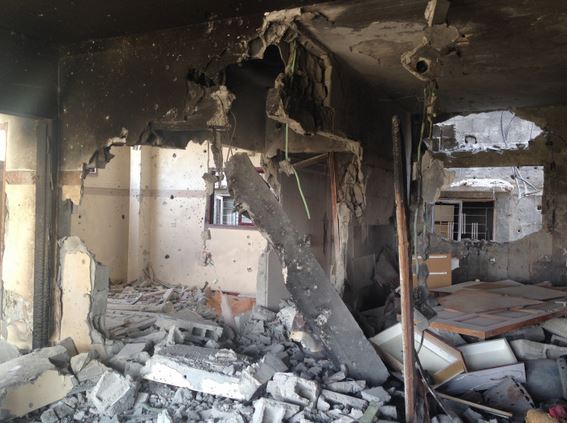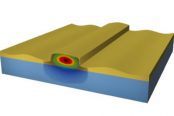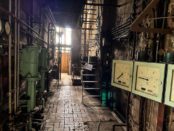[dropcap style=”font-size:100px; color:#992211;”]O[/dropcap]n the 14th of November, Bristol was given the opportunity to watch the first viewing of the film, Palestine: What Hope Peace? by activist and freelance journalist Kerry-Anne Mendoza.
Bristol was an appropriate city in which to introduce her film not only because it is her home, but also because of the variety of ways that it has expressed its concerns for Palestine, including active societies at the university, a two-week occupation outside the BBC buildings back in July along with almost daily demonstrations in the city’s centre, and in particular the establishment of an innovative Palestinian Museum (where Mendoza’s film was shown).
Mendoza has been travelling to Palestine and Israel since 2002, interviewing locals and documenting the conflict and its effects, which she feels is never accurately revealed by the mainstream media. Her latest film, lasting an hour and a half, documents the catastrophes that took place in July and August of this year, which was catalysed by the kidnapping and murder of three Israeli men aged sixteen to nineteen.
Violence towards young people and children is emphasised throughout the film to help us realise the extent of the devastation produced by the conflict. Out of the 1.8 million people that inhabit Gaza, 1 million of them are under eighteen years of age. Mendoza also narrates the terrifying fact that the average eight-year-old living in Gaza has experienced at least four Israeli attacks during their lifetime. The horrors do not stop there: throughout, I was struck by the number of pregnant women referenced or seen in the film, many protecting several young children by themselves in make-shift ‘houses’ next to the rubble of their recently-bombed homes. Mendoza’s guide was in the position of not only looking after her, but also his heavily pregnant wife (who gave birth to a healthy baby soon after Mendoza left).
The bombing of Gaza was fierce and incessant when Mendoza was there in the summer. The complete, merciless wrecking of areas to the extent that there were no basic amenities left made it almost incomprehensible to think how people could still inhabit Gaza at all. They have nothing left but the air around them. [quote]there is nothing left of ‘Palestine’,
just small and disconnected pockets
of pain. Further divisions and
segregation will not work.[/quote]Mendoza claims that it could take twenty years for Gaza to return to its state before this wave of bombings, which of course does not take into account all the previous destruction. This inhumane situation is highlighted by the fact that the Israelis prevent international aid from reaching the Palestinians.
Mendoza confided that she felt alone and scared a lot of the time during her journey, especially when she was isolated in her hotel in Gaza listening to bombs being dropped just a few hundred metres away. She was meant to be staying at the hotel for journalists, but ended up at a deserted hotel (something she only revealed to her family during the questions-and-answers session following this first screening of her film).
In order to emphasise the failings and inadequacies of the mainstream media, which Mendoza claims does not tell the right, or the whole, story of what is happening in Palestine, she adopted a self-reflexive approach to her documentary. At the beginning, she stressed the importance of context for creating meaning by discussing the connotations of pouring water, which can indicate a life-giving source to those without adequate water supplies and also be suggestive of torture. This helped the audience to (refreshingly) feel that there was no pretense to this film; it was aware of its own power and limitations, and needed to reference this for its own credibility.
To argue against the notion of “a two state solution”, Mendoza used the South African apartheid to exemplify that giving a minority group a small degree of control over their poverty and violence-stricken area contains the dark motive of aiming to continue the oppression by forcing them to be docile. The two state solution also looks absurd when you consider not only that Palestine is Israel and Israel is Palestine, and so they are not two separate areas (as they are often talked about in the media), but that there is nothing left of ‘Palestine’, just small and disconnected pockets of pain. Further divisions and segregation will not work. Mendoza acknowledges the complexities of the situation, and feels that for equality to be achieved, Israel cannot be a democracy and continue to be a Jewish state; instead religion needs to become a private practice that does not involve the state.
We are lucky to have this film; it certainly felt a privilege to watch it and be there for its release. Mendoza was let out of Gaza minutes before its borders were closed. She remembered the strange feelings this entailed because she was ushered out (no one asked to look at her film or detained her from taking it out of Gaza), unlike her previous exits, which usually involved hours of interviews in the Israeli Press Office and even instructions to do cartwheels so they could be certain that she was not secretly carrying anything. This year marks the twenty-fifth anniversary of the fall of the Berlin wall. Why are we not rallying in a similar way for the fall of Gaza’s walls? This film makes it very clear that they are trapped inside a living hell.
Palestine: What Hope Peace will continue to tour at selected venues around the country; it is not to be missed.
Photo: Kerry-Anne Mendoza
Bring the film to your school, community centre, cinema or any other venue, together with live Questions and Answers with Kerry-Anne and Khalil, by emailing: scriptonitedaily@hotmail.co.uk
Helen is an independent art critic and curator with an MA in The History of Art from UCL. Her research interests include nineteenth-century French art and ephemeral objects, Rodin’s sculpture and his developments in photography, and contemporary studio craft. She also keeps a blog – helencobby.wordpress.com and a Twitter account: @HelenCobby



















